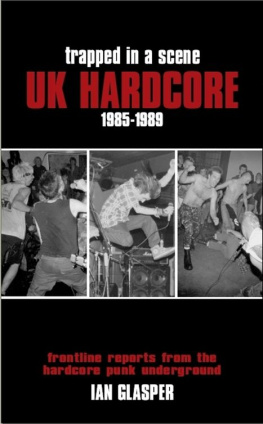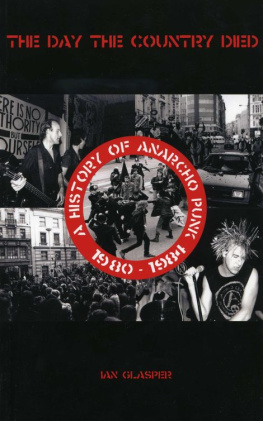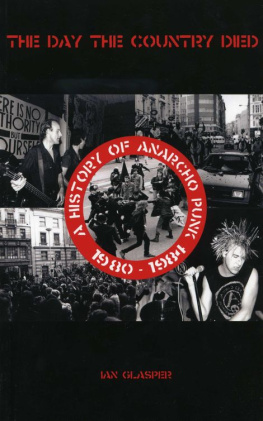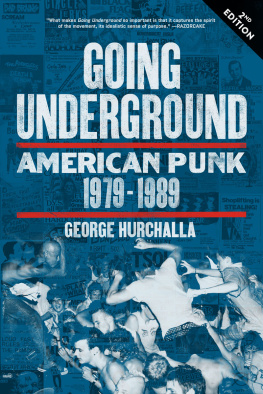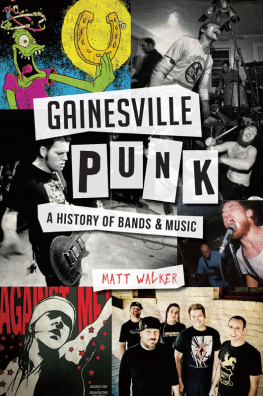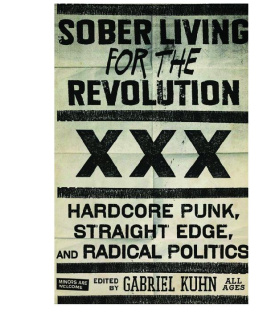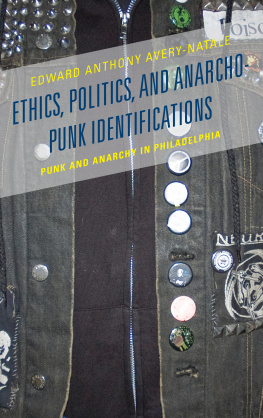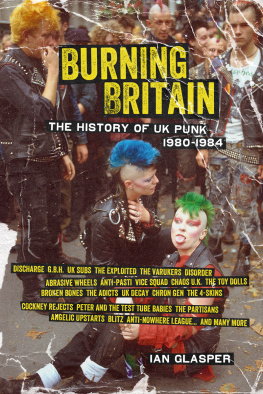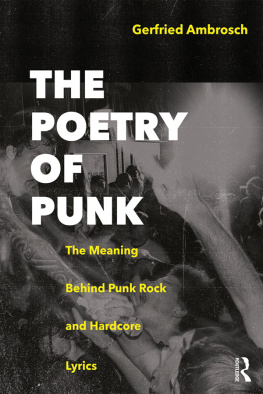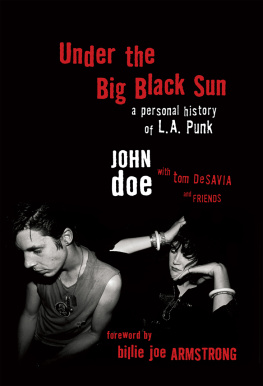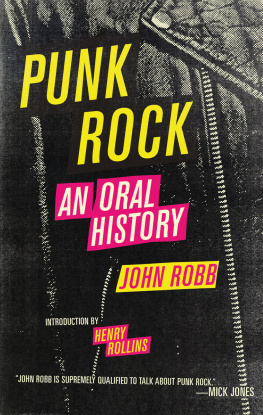My wife Jo, my beautiful kids Amy and Sam Glasper, mum and dad, Iain McNay, Richard, Adam and all at Cherry Red, Michael Heatley, Dave Johnson, Mark Brennan and Captain Oi; (for photos and other visual assistance) Paul May (dead_brit@yahoo.com and www.myspace.com/deadbrit), Jaz Wiseman and Marc Freeman, Sned, Nick Royles, Andy Giles, Andrew Medcalf, Richard Camm, Scotty, Pek, Simon Faulkner, Trunt, Michael Sanderson, Richard White, Roy Wallace; (for proof-reading and general encouragement) James Hoare, Jenn Selby, Steve Cotton, James Sherry, Aston Stephens, Tony Whatley, Sean Forbes, John Esplen; (fellow scribes) Louise Brown, Joel McIver, Micky McGuiness, Alex Ogg, George Berger, Tim Cundle and Marek Kowalsky; (otherwise useless mates only kidding) Mobs, Darren, Welshy, Dez, Rat, Nick Rawle, Gizz, Flux Of Punk Idiots, Suicide Watch, Burnside, Scott Greatwood, Big Barr, Silv and all Ledbury punks past, present and future! Sensei Dave Webster and all at Full Circle Martial Arts; (all the bands, but especially) Scruff, Beddis, Kip, Monti, Rich Militia, Pat Lawlor, Tam, Shrew, Ian Armstrong, Jimmy Whiteley, Rob Bewick, Hammy, Richard and Steve Pils, Lecky and Ian Murphy.
As with Burning Britain and The Day The Country Died, this book is intended to be as comprehensive an overview of the UKHC scene during the mid-to-late Eighties as possible. Of course, the definition of UKHC is totally subjective in itself, so dont be too upset if my definition doesnt align perfectly with your own. Also as per the previous two books, there are bands missing from here that, for whatever reason, could not be contacted in time (three years is long enough for anyone to spend on one project!) Hence the likes of Bad Blood, Life Cycle, Genital Deformities, Suicidal Shopping Trolleys and The Mad Are Sane not making the final cut.
Then there are the bands that were active towards the end of the Eighties but also well into the Nineties that have been held over for a forthcoming book on Nineties hardcore punk, primarily due to space restrictions: Rectify, Sink, Wat Tyler, Herbgarden and Bomb Everything, to name but a few.
All of these bands and many more will be fully documented as soon as I get out of therapy following this volume.
Needless to say, the opinions expressed by all the interviewees are their own, and not necessarily those of the band(s) they were in, or indeed your author. If something you read offends you, take a deep breath and put it in perspective: it happened a long time ago, and everyones since moved on (except you, apparently).
Seriously though, the mists of time are closing in on what was an exciting and formative time in underground music, and this stuff needed to be recorded for posteritys sake, warts n all in some instances. But these books of mine have never been about upsetting anyone, quite the opposite in fact; theyre all about celebrating something that brought people closer together and shaped their lives for the better.
Wherever possible, photographs have been credited accordingly and as accurately as possible, but in some instances pictures were donated by bands that werent entirely sure who took them in the first place! My sincerest apologies to anyone whose photos arent credited if its any consolation, the UKHC scene salutes you for services rendered.
The older folk out there will also know that I was the bassist of Decadence Within, which made the writing of that particular chapter a little tricky. So I ended up referring to myself by my nickname of the time, Slug (dont ask), kept my own comments as unbiased as possible and let the other guys do all the talking.
Now stop complaining, start reading and try to enjoy yourselves!
Peace
Ian Glasper, April 2009
The second half of the Eighties was pretty much as miserable as the first, and dont let anyone tell you any different. Margaret Thatcher may well have been in welcome decline (soon to be pilloried for introducing the massively unpopular Poll Tax/Community Charge and superseded by her insipid Chancellor Of The Exchequer, John Major) but the Iron Ladys boot-boys werent satisfied with just trouncing the miners, and the Battle of the Bean Field in 1985 ended the Stonehenge free festivals once and for all.
The Cold War was thankfully winding down, but a hundred other conflicts were springing up in its place, so the arms trade remained depressingly buoyant. The Chernobyl nuclear power station melted down, the space shuttle Challenger blew up during take-off, and PC Keith Blakelock was killed by an angry mob during riots on Tottenhams Broadwater Farm estate.
Then the British ferry Herald Of Free Enterprise capsized just off Zeebrugge, Michael Ryan rampaged through Hungerford with a rifle, and there was the usual run of train and plane crashes, most notably the Pan Am Flight 103 exploding over Lockerbie in southwest Scotland, in December 1988, killing over 250 people. Yes indeed, cheery times.
And if things werent bad enough, bland rock music was huge, with the likes of Def Leppard, Bon Jovi, Dire Straits and U2 dominating the charts; Michael Jackson was busy being Bad and 1985s Live Aid provided a very handy sticking plaster for our consciences whilst being watched by 400 million people across 60 countries.
For much the same reasons behind the first and second waves of punk rock then, angry youths vented their frustration at the banality of daily life with guitars, drums and defiant voices. They took their lead from the anarcho punk scene of the early Eighties, that had empowered them with its fiercely DIY stance and compassionate politics, but were also devouring exciting new takes on punk music that were being imported from Europe and America. Faster, harder and infinitely more energetic, hardcore music made the more traditional varieties of punk seem a little pedestrian, and enthusiastic youngsters the length and breadth of the country, now bored with their older brothers record collection, were living for the scene reports from Scandinavia and Italy and Boston that were a regular feature in the popular US hardcore fanzine, Maximum RocknRoll. Its almost obligatory to seek out music your parents wont understand and very few parents could wrap their heads around the likes of Larm or Wretched!
Best of all, these hardcore bands from overseas were tearing across the UK on tour, hurling themselves off stages with gleeful abandon and generally helping knock the last few nails into the coffins of the old guard. Why borrow from the Clash and the Stranglers when you could now aspire to Rattus and Siege?
There was also a revolution happening in metal music, a scene that had previously been fairly taboo for punk rockers (Motorhead being a notable exception to this rule); bands like Metallica and Slayer were drawing influence from the likes of Discharge and GBH, and the door swung both ways, with hardcore bands like COC (aka Corrosion Of Conformity), DRI (Dirty Rotten Imbeciles) and Suicidal Tendencies taking fresh inspiration from them. The punk/metal crossover had good strong legs in the UK too, albeit with a scab on the knee from falling over whilst playing footie outside in the road.
Soon everyone was trading tapes, writing their own fanzines, promoting their own gigs and generally helping to create their own scenes in their own towns. Why travel to London to see your favourite band when you could hire a local hall and bring them to you? Indeed, it was Maximum RocknRoll again that encouraged kids everywhere to book their own fucking lives

